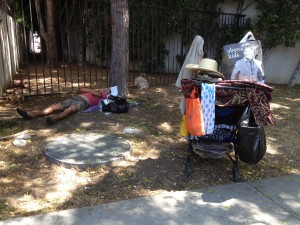The L.A. County Board of Supervisors approved a wide-ranging set of strategies today aimed at combating homelessness, ranging from increasing housing subsidies to boosting the income of homeless families.
Homelessness is “the most serious humanitarian crisis confronting our county today,” county CEO Sachi Hamai said.

A 12.4% jump in homelessness countywide from 2013-15 caught the attention of public officials. Though the results of a recent homeless count are not yet available, the last estimate by the Los Angeles Homeless Services Authority (LAHSA) is that 44,359 county residents are homeless. The annual count found 87 homeless people in West Hollywood in January, more than twice the 43 found in WeHo in 2014.
The “unsheltered” population living in tents, makeshift shelters and vehicles has grown even more dramatically, up 85% over the same two-year time period to more than 9,300 people, according to LAHSA.
A video showing what Hamai called the “critical stakes” featured a family with small children who had been forced to live in their 1997 Chevy Suburban when both parents lost their jobs and a Lancaster attorney who lost his home to drug addiction.
“My attitude before I became homeless was, `How could you be homeless?'” attorney Don Arnold said of the people he used to pass on the street on his way to work. “Now I understand.”
The board’s strategies follow recommendations by the county’s Homeless Initiative task force, established last year when the board committed to spending more than $100 million on the problem.
“This plan is ambitious and … achievable,” Hamai said.
The 47 strategies drive six objectives, including preventing homelessness, subsidizing housing, increasing income, providing case management and services, creating a coordinated system and increasing affordable housing.
Together they are expected to “bring widespread humanitarian relief to our most vulnerable neighbors” and save the county money, LAHSA Executive Director Peter Lynn told the board.
The county spends nearly $1 billion annually to provide medical, mental health and social services to homeless people, as well as to pay for the deputies and probation officers who work with the homeless population.
About 5 percent of that population consumes 40 cents of every dollar spent, according to county research. The board agreed to prioritize services for those individuals.
“A real bed is much less expensive than a jail bed or a hospital bed,” Phil Ansell, director of the Homeless Initiative, told the board.
The first phase of work, to begin no later than June 30, is focused on strategies expected to have the most impact in the shortest time frame. The county is set to spend $42 million over 12 months, helping 3,500 people off the streets and preventing another 2,000 from becoming homeless.
In addition to providing more housing subsidies in a variety of forms, the first phase will include strengthening the shelter system as an entry point to a broader set of services.
Phase one priorities also include finding work for those who face barriers such as criminal records or substance abuse problems and making sure that disabled individuals are receiving federal benefits, putting both groups in a position to pay for their own housing.
Supervisors Sheila Kuehl and Don Knabe highlighted the concerns of domestic violence victims. “In 2015, nearly 65 percent of all homeless women reported that they had been victims of domestic violence. Our … motion will explore ways to ensure that individuals and families fleeing domestic violence are provided adequate housing and services,” Kuehl said.
A summit is planned to help pin down specific city initiatives with each of the county’s 88 municipalities. The mayors of several of those cities — including Inglewood, Lynwood, Lawndale, Culver City, Compton, Torrance, El Monte and West Hollywood’s Lindsey Horvath — joined the board to show their support.
“Many hard-working families that have bought into the American dream are literally one catastrophe, unplanned expense, job loss or illness away from being displaced,” Compton Mayor Aja Brown told the board.
Many of the county strategies rely, at least in part, on city implementation.
The Los Angeles City Council has been coordinating with county officials and approved its own set of initiatives today, projected to cost $1.87 billion over a decade. Mayor Eric Garcetti — through a spokesman — called the county’s plan “bold and visionary.”
The county strategies are detailed, but the specifics of implementation and the source of funding for future years are yet to be worked out. The board was optimistic.
“The plan makes no claim about perfection, but … we will make substantial progress,” Supervisor Mark Ridley-Thomas said. The vote was unanimous.
